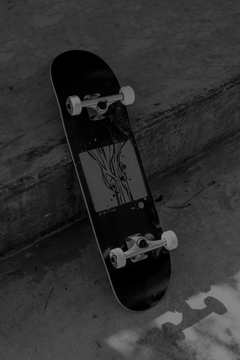Complete Skateboard
Completes: We’ve taken the headache out of selecting individual components which make up a skateboard by offering assembled “completes”. For those unsure of what to select, you cannot go wrong with any of these options.
You can also put together your own complete by picking out a deck, trucks, wheels and bearings. We will happily put it all together and ship it out to you.

Skateboards: Seven thin plys of maple are glued together to make a skateboard deck. They are almost all 32 inches long, but vary slightly in width and concave (flatness) – these are the two variables that seasoned skateboarders develop preferences for. There is no right or wrong when it comes to decks. If you are new to skateboarding, any choice you make will do just fine! Generally speaking, deck width options increase by ¼ inch increments with 7.75 inches considered the narrowest and 8.75 considered the widest.

Trucks: are the set of metallic components located under the skateboard. They allow for the skateboard to turn and grind. One truck consists of a hanger and a baseplate, held together by a kingpin. Trucks are attached to a skateboard with hardware at the baseplate. Wheels (equipped with bearings) are attached at both ends of the hanger (on the axle) while polyurethane bushings are included on the kingpin to facilitate turning. There aren’t many variables to consider when selecting trucks. Some have hollow axles. Some are made from lighter materials. The most important thing is to select trucks with axles sized to match the width of your board (deck). Unfortunately, all truck companies have their own way of indicating axle lengths. Refer to this sizing chart for clarification.

Wheels: Skateboard wheels are made up of polyurethane and are shaped to contain bearings. Three main variables should be considered when selecting wheels. The first is size (diameter), the second is durometer (softness). Generally speaking, wheel sizing options increase by one milimeter increments with 50 mm considered small and 60 mm considered big. Lower durometer valued wheels (starting at about 70) are softer while higher durometer valued wheels (ending at about 100) are harder. Smaller, harder wheels are meant for performing aerial skateboard tricks under smooth conditions (ex. a skateboard park with fresh concrete). Larger, softer wheels are tougher to get off the ground (not ideal for tricks) but are great for tackling non-ideal conditions (ex. old asphalt). The last variable to consider is the shape of the wheel. Although all skateboard wheels will (obviously) be round, some are cut to specific shapes with different intentions in mind (for ex. certain wheels are shaped to facilitate smoother grinding). This variable is the least important, in comparison to the first two.

Bearings: Although they vary in what they are made of, all skateboard bearings are standardized to fit into skateboard wheels. They contain lubricated metallic balls and are the key to a smooth ride. To maintain this smooth ride, it is important to keep your bearings clean (avoid water and sand while skateboarding). Some may choose to clean their bearings from time to time, but do not do so with WD-40! You will ruin your bearings. Only special bearing lubricant should be used to clean them.

Helmets: Safety first! Protect your head by wearing a helmet that fits while skateboarding.
Sizing: Head Circumference Measurement (inches)
20.5 - 21.3 XS
21.3 – 22 S
22 - 22.8 M
22.8 – 23.6 L
23.6 – 24.4 XL


